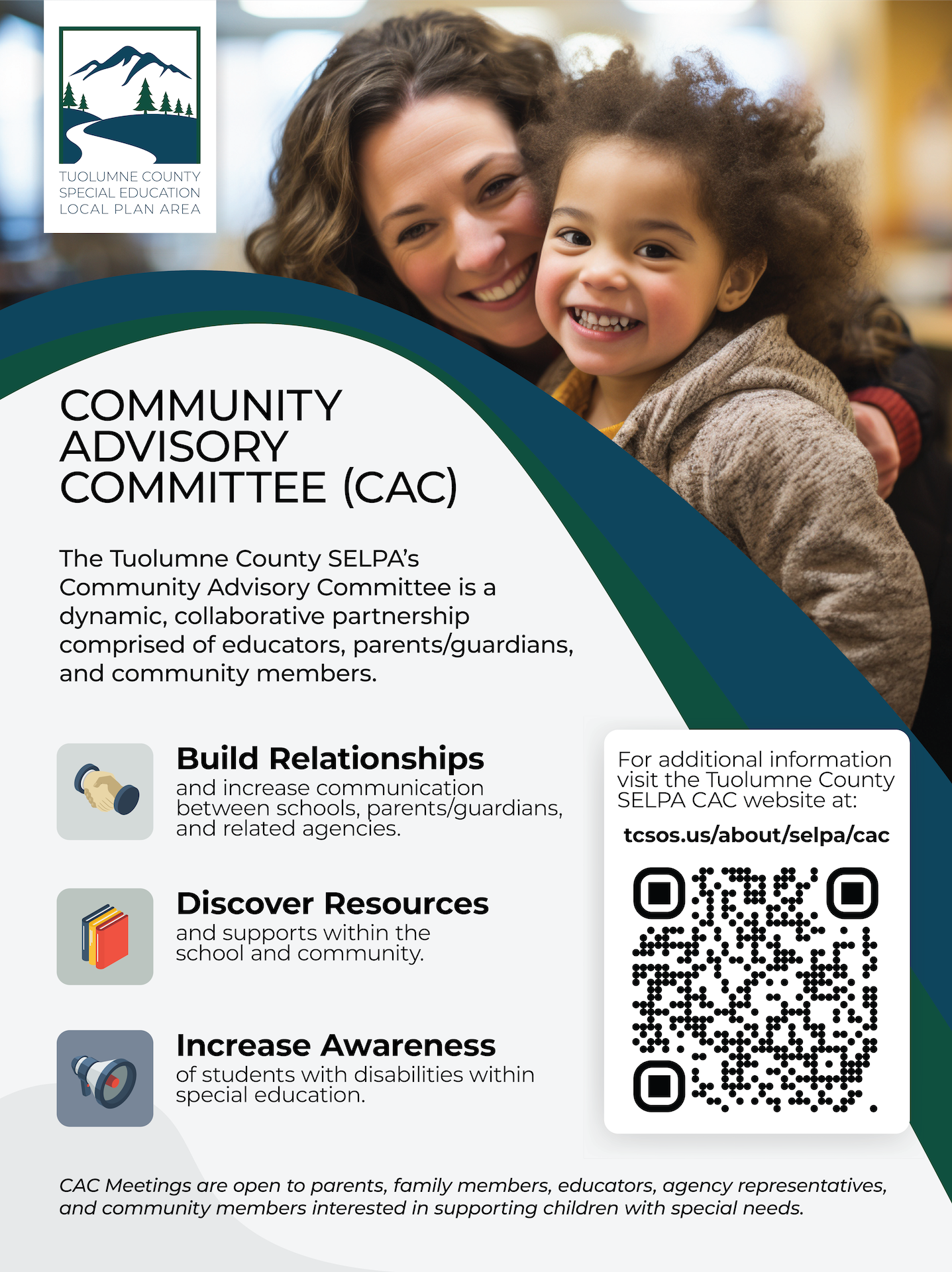Community Advisory Committee (CAC)
CAC
Responsibilities
Community Advisory Committees have specific and vital roles and responsibilities, which are reviewed in detail in the California SELPA Community Advisory Committee Guide, 5th Edition, 2022.
The responsibilities shall include, but need not be limited to, all the following:
- Provide a support group for parents and students
- Provide an opportunity to talk with professionals who work with children with special needs
- Increase awareness of available service options
- Increase awareness of the importance of regular school attendance
- Encourage community involvement in the development and review of the local plan for special education
- Plan or provide parent education and training
- Support activities on behalf of children with special needs
- Provide an open forum for discussion, committee reports, and guest speakers through CAC meeting
CAC Flyer
Community Advisory Committee Information
CAC Member Interest Form
If you are interested in serving on the CAC, please complete the nomination form and your application will be reviewed by the SELPA Governing Board.
CAC Meetings
& Workshops
CAC Meeting
Agendas
Parent & Community
Education
Acronyms Used in Special Education
- ADA – American with Disabilities Act,
- Average Daily Attendance
- ADR – Alternative Dispute Resolution
- ALJ – Administrative Law Judge
- APE – Adapted Physical Education
- AU – Administrative Unit
- BIP – Behavior Intervention Plan
- CAA – California Alternative Assessments
- CAASP – California Assessment of Student Performance and Progress
- CAC – Community Advisory Committee (see Resource Parent Council section)
- CalSTAT – California Services for Technical Assistance and Training
- CASEMIS – California Special Education Management Information System
- CAST – California Alternative Science Test
- CBEDS – California Basic Educational Data System
- CCR – California Code of Regulations, Coordinated Compliance Review
- CCS – California Children Services
- COLA – Cost of Living Adjustment
- CDE – California Department of Education
- CFR – Code of Federal Regulations
- COE – County Office of Education
- DINC – Data Informed Non-Compliance
- EC – Education Code
- ECE – Early Childhood Education
- ESY – Extended School Year
- FBA – Functional Behavioral Assessment
- FAPE – Free and Appropriate Public Education
- FEP – Fluent English Proficient
- FERPA – Family Education Rights and Privacy Act
- FFH – Foster Family Home
- FIEP – Facilitated Individualized Educational Program
- FMTA – Focused Monitoring Technical Assistance
- FRC – Family Resource Center
- FTE – Full-Time Equivalent
- GGRC – Golden Gate Regional Center
- IA – Instructional Assistant
- IDEA – Individualized with Disabilities Education Act
- KPI – Key Performance Indicators
- HI – Hearing Impairment
- ID – Intellectual Disability
- IEE – Independent Educational Evaluation
- IEP – Individualized Educational Program
- ISP – Individual Services Plan
- IFSP – Individual Family Service Plan
- ITP – Individual Transition Plan
- LCI – Licensed Children’s Institutions
- LEA – Local Educational Agency
- LEP – Limited English Proficient
- LIF – Low Incidence Funding
- LRE – Least Restrictive Environment
- MIS – Management Information System
- MTU – Medical Therapy Unit
- NPA – Non-Public Agency
- NPS – Non-Public School
- OAH – Office of Administrative Hearings
- OCR – Office of Civil Rights
- OHI – Other Health Impairment
- OI – Orthopedic Impairment
- O&M – Orientation and Mobility
- OSEP – Office of Special Education Programs
- OT- Occupational Therapy
- PIR – Performance Indicator Review
- PT – Physical Therapy
- QAP – Quality Assurance Process
- RLA – Responsible Local Agency
- RSP – Resource Specialist Program
- SAI – Specialized Academic Instruction
- SCIA – Special Circumstances Instructional Assistance
- SEA – State Educational Agency
- SEIS – Special Education Information System
- SDC – Special Day Class
- SOP – State Operated Programs
- SLD – Specific Learning Disability
- SST – Student Study Team
- SLI – Speech/Language Impairment
- STAR – State Testing and Reporting
- TBI – Traumatic Brain Injury
- TDS – Therapeutic Day School
- ED – Emotional Disturbance
- SELPA – Special Education Local Plan Area
- VI – Visual Impairment
Child Find
The Tuolumne County SELPA is seeking young people from birth to age 21 who may need special education services, including highly mobile (such as migrant or homeless) children with disabilities and children who are suspected of having a disability and in need of special education. If you believe your child may have any of these special needs, please get in touch with your local school district or the SELPA Office at (209) 536-2054.
Community Agencies Weblinks
Links to regional agencies, etc.
